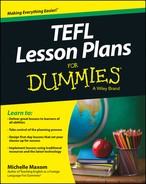Chapter 24
Making Use of Readers
In This Chapter
![]() Seeing how readers can support learning
Seeing how readers can support learning
![]() Drawing inspiration from readers to motivate students of all levels
Drawing inspiration from readers to motivate students of all levels
![]() Linking reading activities with other media to stimulate interest in reading skills
Linking reading activities with other media to stimulate interest in reading skills
Graded readers are small books, mostly fictional, that are written to suit a particular level of proficiency in English. They’re self-study resources and some are original stories, whereas others are adaptations from other works. Many schools keep a library of graded readers for students to borrow and take home.
In this chapter, I show why bringing readers into the classroom as lesson content is a great idea, and how you can best do so. Some schools purchase a class set of the same book (many copies of the same reader), which is ideal for classroom work. In other cases all the students have a different reader. I show you a lesson that presents the same story in two formats, a graded reader and a Hollywood movie, to teach a language point in a memorable way.
Using Readers as a Lesson Resource
Reading in English is a skill to encourage because as it enables students to access far more vocabulary, grammar and cultural input than you could ever teach during the course. And, of course, good reading skills generally translate to better writing skills.
Using readers is great because
- Reading these tailor-made books gives students the confidence to read English in general. At first they are too intimidated by the new language to read stories, but when they manage a short, reader and find it enjoyable they begin to read other material in English too.
- Readers are graded to make the reading experience more pleasurable. So each book is labelled to show how difficult it is based on the grammar and vocabulary content. That’s why students don’t have to keep stopping to consult the dictionary as long they’re reading at the right level.
- Many readers come with an audio CD in which the receptive skills (listening and reading) are linked together. The student also has access to a good pronunciation model.
- Building vocabulary is important for increasing language proficiency. Readers enable students to find new vocabulary within a clear and interesting context.
- Preparing to study a particular reader prompts research for background information about the author and the setting. In the example I use in the lesson plan, the Amistad account presented in the reader tends to generate interest in slavery, the actor Djimon Hounsou and American history. Students therefore expand their general knowledge and so have more material to discuss with classmates and write essays about.
- Extended reading, as provided by readers, allows students to consolidate what they have been learning in class by seeing it reinforced in black and white.
This lesson is designed to give you ideas about combining graded readers with other media to provide context for a language point. It also whets the students’ appetites for further reading of the book in question or of background information.
Lesson overview
Doing a warmer activity
![]() 5 minutes
5 minutes
Find out from students what they know about two of the principal actors in the film they’ll later view: Djimon Hounsou (starred in Gladiator and Blood Diamond) and Matthew McConaughey (starred in The Wedding Planner and A Time to Kill). Show pictures and provide some background information about the actors. Explain that the two men starred in Spielberg’s film Amistad about Mende people from Africa who, in 1839, broke free from their captors while on a slave ship to America, but then faced a huge legal struggle for the right to return home.
Introducing the modal perfect
![]() 7 minutes
7 minutes
Write a list of modal verbs on the board and ask students how to use them to talk about the past. Draw a chart like the one in Table 24-1 and elicit the information to fill it in.

![]() 8 minutes
8 minutes
Now get students to construct five or six sentences about the Amistad story using the modal perfect form. Provide prompts for their sentences in this way:
Use the verb in brackets to complete the sentence in the modal perfect form. Write your own opinion.
- Spielberg [to choose] Asian actors for this film.
Spielberg can’t have chosen Asian actors for this film because it’s set in Africa and the USA
- After reading the story the filmmakers [to go] to Africa for advice.
After reading the story the filmmakers might have gone to Africa for advice.
- The people in the real Amistad story [to be] really happy to win their freedom.
The people in the real Amistad story must have been happy to win their freedom.
After students have compared their answers, go through the exercise with the class, paying attention to their use of grammar.
Working with the graded reader
![]() 5 minutes
5 minutes
The same scene is portrayed in the Penguin graded reader Amistad and in Spielberg’s film. First students read a scene in the book.
Explain the background to this scene: After weeks of struggle, a court has granted the Africans in America their freedom. Baldwin, the lawyer, and Covey, the interpreter, speak to Cinque, a brave African who was celebrating in prison.
Give students a minute or two to read the scene in the book by themselves. Here is an extract from the graded reader (page 31):
- They sat down at a table outside the prison. Baldwin began to speak. Covey repeated his words.
- ‘Our president, our “big man’’ wants your case to go to a higher court’.
- ‘What does that mean?’ asked Cinque.
- ‘It means’ said Baldwin, ’that a different judge will have to decide the case again.’
- ‘No!’ shouted Cinque. ‘We had a decision. We’re free!’
- ‘That’s almost true … ’ began Baldwin.
- ‘Almost?’ Cinque asked.‘ Almost? What sort of place is this? Where you almost mean what you say? Where people are almost free?’
Predicting
![]() 10 minutes
10 minutes
Ask the students to work in threes and predict how they think the actors, Hounsou, McConaughey and Chiwetel Ejiofor (who plays the interpreter), will portray this scene in the film.
Write a list of adverbs on the board, like worriedly, desperately, angrily, cautiously, suspiciously, and apologetically. Students can use these adverbs to describe each action that takes place, or they can use their own ideas. Dictionaries are allowed.
For example:
- Student A: I think the lawyer sits down cautiously because he knows he has bad news to give them.
- Student B: Maybe Cinque sits suspiciously because he can see that Baldwin wants to say something bad.
Role-playing the scene
![]() 5 minutes
5 minutes
In groups of three, students act out the short scene. Instead of the Mende language, if some of your students share the same first language and are in the same group, they can take the parts of Covey and Cinque, translating from English into their own tongue such as Spanish or Chinese. As each group acts, the group members must try to convey the emotions of the various characters.
Linking the graded reader to the film clip
![]() 16 minutes
16 minutes
Now the students watch the dramatic film clip to see whether their predictions were actually right. After watching, they discuss in pairs the appropriate adverbs to describe the actors’ portrayal. Find out whether they’re surprised by Spielberg’s version.
Next students watch the scene again and complete the gapped text of the film script shown in Figure 24-2. It highlights the problem posed by translating modal verbs. The gaps in the text are mainly in Baldwin’s words, which are repeated frequently. Let the students know that this is the reason why numbers for the gaps are also repeated in the text. You see in the script that number one, for example, appears twice. I have filled in gap one as an example for the students to follow.
Play the scene straight through once, but if the students still have gaps, play it a second time. Students compare their answers, and then you give general class feedback.

Figure 24-2: Fill the gaps worksheet for Amistad film listening and watching activity.
Answers: 1. Judgement; 2. Free; 3. shouldn’t have; 4. Said; 5. meant to; 6. Almost; 7. Always;
Discussing issues raised in the book
![]() 9 minutes
9 minutes
In pairs or small groups students discuss the following questions related to the scene:
- Do you think the lawyer should have explained more about the court system before the case first went to trial? Why or why not?
- Is it fair that you can win your case in one court but then lose it in another?
- Cinque seems to find America a very strange place. What do you find strange about British/American culture?
- Which word from your language has no direct translation into English? How would you try to explain the word to an English speaker?
Ask a few students to summarise the opinions expressed in their pair/group to the whole class.
Extension activities
At this point students are usually anxious to know what happens to Cinque and the others. Set the students more reading work from the book to do at home. You can then discuss the importance of freedom and human rights during class time.
Ask the students to research and tell the story of someone who fought for something that’s considered important in their country. This information can then also be used as an essay topic.

 If you have a library of readers in your school, don’t just leave them for students to study by themselves. Without your input, students may not be motivated to take English-language books out and develop their reading skills. So bring books into the lesson to raise awareness of how advantageous they are to language learners.
If you have a library of readers in your school, don’t just leave them for students to study by themselves. Without your input, students may not be motivated to take English-language books out and develop their reading skills. So bring books into the lesson to raise awareness of how advantageous they are to language learners. Hounsou’s story is an interesting rags-to-riches tale. He was homeless in France when he was discovered, and he became a fashion model and later a Hollywood actor. Use his story as a springboard. Students can give presentations about a similarly dramatic rise to fame of a celebrity from their own country.
Hounsou’s story is an interesting rags-to-riches tale. He was homeless in France when he was discovered, and he became a fashion model and later a Hollywood actor. Use his story as a springboard. Students can give presentations about a similarly dramatic rise to fame of a celebrity from their own country.